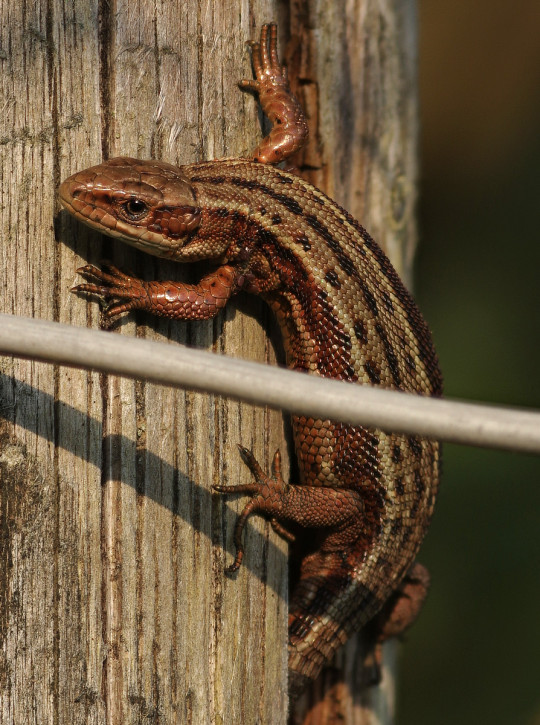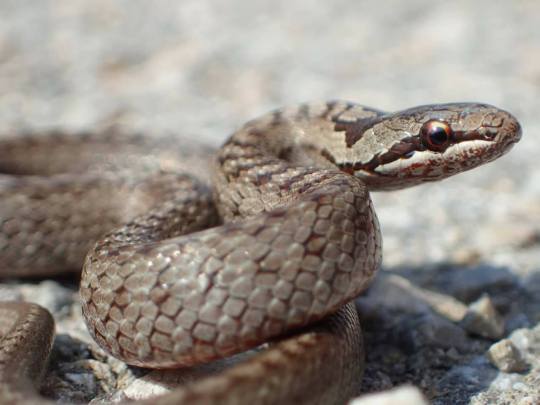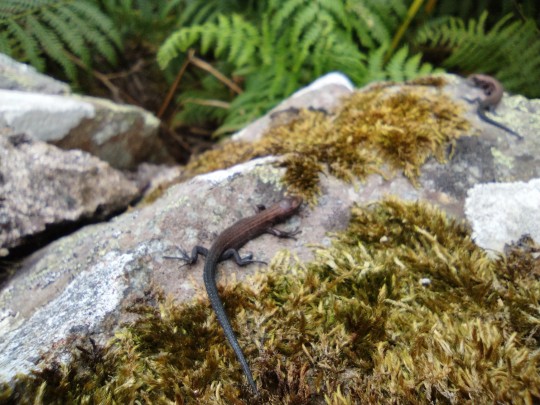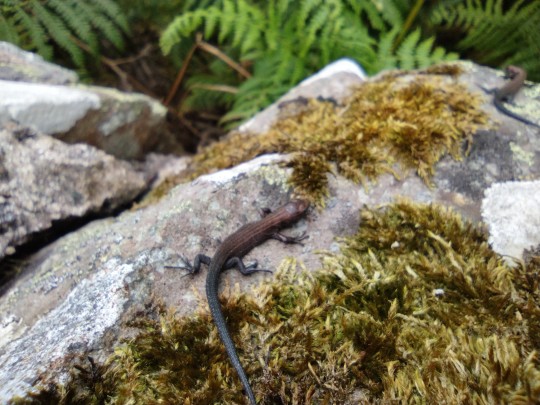#zootoca
Note
Hi!! Hello! Dane here. I have a question that might be really dumb and silly- but basically the area I live in, at least when I was a kid (it’s been a while since I’ve gone lookin’) has a lot of firben (not sure which kind sorry) who are all-black? I’m aware that melanistic reptiles and amphibians aren’t that rare but I always wondered what this specific species of firben was. But since they were all all-black I could never figure it out!
All I can tell is I live near a pond with tall vegetation, far from other large water sources, and the lil guys were 4-8cm long?
Oh and it’s in Jylland!! Do you have any good places for looking up these little fellas? I’m sure they were just a really common type of firben that had a bit of a limited gene pool and for some reason black was advantageous in the little pond, but I vaguely remember the texture of their skin and such and it’s been buggin me for YEARS! So if you have anything to help me end my search: thank you 😭
Hej! This is probably a population of melanistic Zootoca vivipara, given the habitat you describe This might indeed have been a coincidence caused by population drift in a small population. It wouldn't even need to be beneficial, just not actively detrimental.
96 notes
·
View notes
Text

Catching the last few rays at sunset.
24 notes
·
View notes
Text

A viviparous lizard (Zootoca vivipara) in Sweden
by Hanna Knutsson
#viviparous lizard#lizards#reptiles#zootoca vivipara#zootoca#lacertidae#squamata#reptilia#chordata#wildlife: sweden#wildlife: europe
84 notes
·
View notes
Text


Couple of female common lizards (Zootoca vivipara) from Greater Cumbrae.
I am very fortunate to occasionally get to help out on a research project investigating reproductive modes in the beautiful creatures!
8 notes
·
View notes
Text

Skovfirben (Zootoca vivipara)
Viviparous Lizard (Zootoca vivipara)
#Skovfirben#Zootoca vivipara#Zootoca#Viviparous Lizard#Lizard#Firben#Krybdyr#Reptil#Reptile#Almindelig Firben#Lacertidae#Forår#Spring#Bygholm Vejle
3 notes
·
View notes
Video
Viviparous Lizard (Zootoca vivipara) by Will Atkins
Via Flickr:
female
#Viviparous Lizard#Common Lizard#Zootoca vivipara#Zootoca#lacertid#Lacertidae#Wildlife#Wildlife of Europe#European Wildlife#Animal#Nature#animal portrait#reptiles#reptile#reptiles of Europe#European reptiles#lizard#Lizards#Lizards of Europe#British Wildlife#British amphibians and reptiles#British reptiles and amphibians#British reptiles#British lizards#UK wildlife#UK reptiles and amphibians#UK amphibians and reptiles#UK reptiles#UK lizards#Dorset wildlife
1 note
·
View note
Text




Лучше попугая на плече только лесная гостья-живородящая ящерица (лат. Zootoca vivipara). Май 24. The only thing better than a parrot on the shoulder is the forest guest-viviparous lizard (lat. Zootoca vivipara). May 24.
#русский tumblr#Россия#природа#весна#загородом#лес#пресмыкающиеся#живородящая ящерица#солнечныйдень#мои фото#Russia#nature#nature photography#spring#sunny day#forest#reptiles#viviparous lizard#Zootoca vivipara#my photos#nature photopragpy#original photography#photographers on tumblr
181 notes
·
View notes
Text


173 notes
·
View notes
Text

Common Lizard
A small common lizard, with a missing tail, sunbathing on a bramble leaf at Glapthorn Cow Pastures.
#animal#animals#canon#canonuk#common lizard#glapthorn#glapthorn cow pastures#lizard#nature#nature reserve#northamptonshire#northants#outdoors#reptile#reptiles#viviparous lizard#wildlife#wildlife trust#wildlife trusts#woodland#woods#zootoca vivipara
3 notes
·
View notes
Text


Zootoca vivipara (viviparous lizard)
#Zootoca vivipara#viviparous lizard#common lizard#lizard#polish animal#wild animals#animal lover#reptile#animal photoshoot#animal photography#animal#wildlife photography#wildlife pictures#wildlife#beautiful#beautiful photos#my photo#photography#photooftheday#naturecore#photoart#forest#woods#forest view#walking in nature#nature#goblincore#goblin aesthetic#goblin community#green energy
19 notes
·
View notes
Text

Viviparous lizard, or common lizard (Zootoca vivipara, scandinavia)
#viviparous lizard#Zootoca vivipara#common lizard#photography#lizards#look at this beautiful lady#she lives under the stone stairs in the garden#my photos
3 notes
·
View notes
Note
Can you share some good photos/resources of reptiles native to the UK?
UK REPTILES
Well, as you may know, there aren't that many reptiles native to the UK.
You have 3 snakes:
Grass snake, Natrix natrix
Adder, Vipera berus
Smooth snake, Coronella austriaca
and
You have 3 lizards:
Common lizard, Zootoca vivipara
Sand lizard, Lacerta agilis
Slow worm, Anguis fragilis
Some resources:
The British Herpetological Society (thebhs.org)
List of reptiles of Great Britain - Wikipedia
Reptiles & amphibians | Amphibian and Reptile Conservation (arc-trust.org)
ID Guide British reptiles – British Naturalists' Association (bna-naturalists.org)

Grass Snake (Natrix natrix), family Colubridae, England, UK
aka Ringed Snake or Water Snake
photograph by Mark Ollett

Smooth Snake (Coronella austriaca), family Colubridae, found in much of Europe
In the UK, this snake is found in limited locations in the South of England.
photograph by Mihai Si Furia Rosie


Sand Lizard (Lacerta agilis), female and male, family Lacertidae, found over much of Europe, and into western Asia
This lizard is found in isolated populations across the UK.
photographs by George Chernilevsky
148 notes
·
View notes
Text



Newly hatched common lizards (Zootoca vivipara) on Greater Cumbrae, likely no more than a week old
3 notes
·
View notes
Text

Wall lizard (Podarcis muralis) ; Sand lizard (Lacerta agilis) ; Viviparous lizard (Zootoca vivipara)
Reptiles and Amphibians of the World. Written by Hans Hvass. Illustrated by Wilhelm Eigener. Originally published in 1958.
Internet Archive
152 notes
·
View notes
Video
Common lizard, with her young. Firfisle, mor med unge by Harald Bøhn
Via Flickr:
"Nordfirfisle også kalt bare firfisle (Zootoca vivipara). Det vitenskapelige navnet var inntil nylig Lacerta vivipara, men arten er nå plassert i den monotypiske slekten Zootoca. Vivipara hentyder til at denne arten føder levende unger. Dette er ikke helt riktig, men nordfirfisla er ovovivipar. Dette innebærer at eggene blir klekket samtidig som hunnen legger dem. Dette er en tilpasning som er vanlig blant krypdyr som lever i kaldt klima: Ungene kan utvikle seg raskere dersom de oppholder seg lengst mulig i kroppen til hunnen fordi hun velger å oppsøke varme steder. Faktisk er alle norske krypdyr, unntatt buormen, ovovipare. Antall unger hos nordfirfisla varierer fra to til ti, og de er 4 - 4,5 cm ved «fødselen». Det første året er ungene ensfarget mørke, ofte helt svarte. Når de er årsgamle, får de den voksne brune fargen med tegninger. Maksimallengden er 17 - 18 cm, og hunnen er gjerne noe større enn hannen. Om vinteren går nordfirfisla i dvale." Sitat Wikipedia no.wikipedia.org/wiki/Nordfirfisle "The viviparous lizard or common lizard (Zootoca vivipara, formerly Lacerta vivipara) is a Eurasian lizard. It lives farther north than any other reptile species, and most populations are viviparous (giving birth to live young), rather than laying eggs as most other lizards do. The name of the species is derived from its ability to give birth to live young, an adaptation to a cool climate – but some southern populations are oviparous (egg-laying). The 3-10 young (or eggs) are usually produced in July. The blackish young measure about 3 cm, and when first born are surrounded by egg membrane, from which they break free after about a day." From Wikipedia en.wikipedia.org/wiki/Viviparous_lizard
1 note
·
View note

